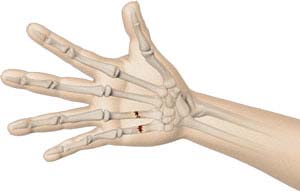
Hand Fracture
The hand is one of the most flexible and useful parts of our body. Because of overuse in various activities, the hands are more prone to injuries, such as sprains and strains, fractures and dislocations, lacerations and amputations while operating machinery, bracing against a fall and sports-related injuries.
A hand fracture is a break in one of the bones in the hand, which occurs when force greater than the bearable limit is applied against a bone.
Symptoms
The most common symptoms of a hand fracture include severe pain, swelling, bruising or bleeding, deformity and discoloration of the skin, and limited mobility of the hand.
Diagnosis
The diagnosis of a hand fracture is based on the patients history, physical examination and X-ray imaging to determine the type and severity of the fracture. X-rays are the most widely used diagnostic tools for the evaluation of fractures.
Treatment
It is important to ensure that the involved part of the body returns to its previous function after the fracture heals. To achieve this, maintenance of the fracture reduction with immobilization techniques is done by either non-operative or surgical methods.
Non-operative Therapy
The bones can be realigned by manipulating them into place in a procedure called closed reduction. Following this, splints or braces made up of fiberglass or Plaster of Paris material may be used to immobilize the bones to allow them to heal.
Surgical Therapy
Surgery typically involves either closed reduction and percutaneous pinning or open reduction and internal fixation. During surgery, the fracture site is assessed with fluoroscopy. If the bones can be satisfactorily re-aligned with manipulation without opening the skin, wires will be introduced percutaneously to stabilize the bone in appropriate position. If the fracture cannot be re-aligned with closed methods, an incision will be made to expose the fracture site, the bones are realigned and then stabilised with wires, a plate and screws or intramedullary devices.
Rehabilitation
Fractures may take several weeks to months to heal completely. You should limit your activities even after the removal of the cast or brace so that the bone becomes solid enough to bear stress. A rehabilitation program involving exercises and a gradual increase in activity levels to strengthen the muscles and improve range of motion is recommended.
Hand therapy is a rehabilitation technique to improve the strength and restore functional activity of the hands in patients with upper extremity injuries. It may be initiated within a few days of the injury or surgery and continued until the patient returns to normal activities. Rehabilitative hand therapy aims at minimizing swelling and managing sensitive scars whereas preventive therapy is recommended for minimizing pain, decreasing repetitive firing of sensual impulses in injured nerves, improving motion and strength, preventing or correcting injuries using specially designed splints, teaching ways to cope with pain and new techniques for performing regular activities, and ensuring a complete recovery.
Related Topics
- Osteotomy for Distal Radius Malunion
- Wrist Open Reduction and Internal Fixation
- ORIF of Distal Radius Fracture
- Trapeziectomy
- Peripheral Nerve Repair
- Wrist Arthroscopy
- Microvascular Surgery
- Wrist Joint Replacement
- Carpal Tunnel Release Surgery
- Wrist Ligament Reconstruction
- Total Wrist Arthrodesis
- Hand Fracture Surgery
- ORIF of the Forearm Fractures
- Endoscopic Carpal Tunnel Surgery
- Wrist Fracture Fixation
- Sports Injury Management of Hand, Wrist and Elbow





